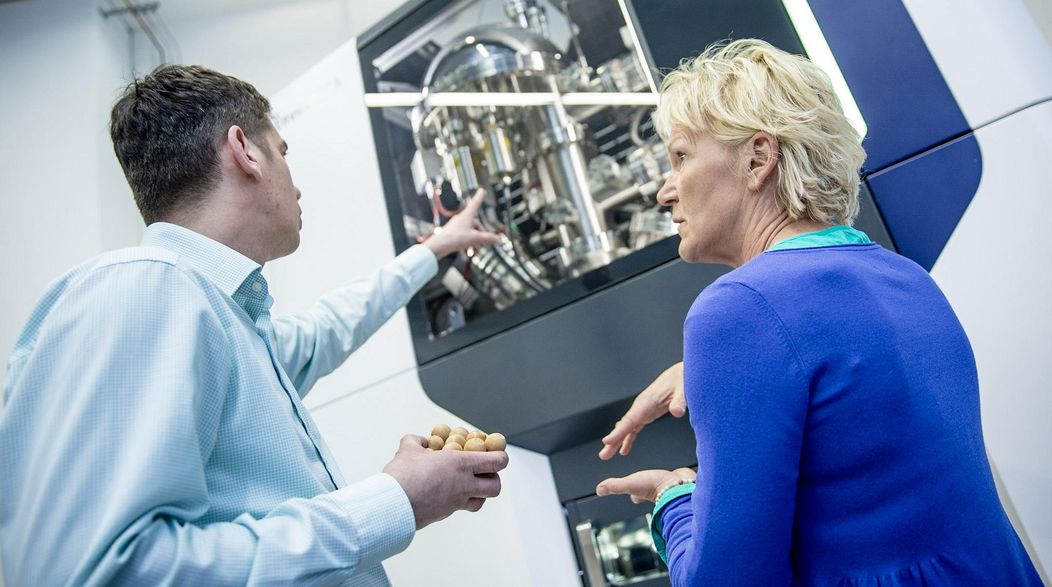Latest add-ons enhance the capabilities for our customers
The SPECS EnviroESCA, introduced to the market about 5 years ago, is the only fully automated ESCA/XPS system capable of operating at pressures up to 50 mbar, thus enabling experiments on non-vacuum compatible samples, including liquids. Since it is such a unique machine, many researchers were thrilled to have the opportunity to send in their samples and have them analyzed by our applications experts on the EnviroESCA prototype machine, which served since its installation in 2017 as a resident demo machine at our headquarters in Berlin. In this function the system impressed many visitors, coming by to attend an EnviroESCA demo or stepping into the lab by chance. A total of 41 scientific publications built around data collected on the EnviroESCA demo system, some of which are referenced below, attest to the great performance and versatility of the EnviroESCA system. It even convinced customers to buy the refurbished demo system right away, now serving in their laboratory as a workhorse in every day operation.
The replacement system will be up and running by end of April. It will be a new EnviroESCA, of course, including a number of experimental add-ons to make the machine even more versatile and fulfilling even more wishes of our customer base. Those add-ons include heating and cooling capability by resistive button heater and Peltier cooling cell, enabling experiments from 0 °C to 600 °C, a state of the art gas cluster ion beam (GCIB) sputtering system and a liquid cell. Using these capabilities, we will continue to demonstrate the unique power of EnviroESCA by generating excellent data for potential customers, using their very own samples. The demo system will furthermore be ready to fill the needs of researchers, academic or industrial, who require service measurements on such a unique ESCA/XPS machine.
X-ray photoelectron spectroscopy (XPS) has become a routine analysis method to determine the chemical composition and bonding states of elements of sample surfaces in many industrial applications, like materials development, failure analysis, quality control and device certification. To obtain significant results the analyses of such samples require a fast analysis with reliable quantification and stable data for repeated experiments. In standard XPS experiments under ultrahigh vacuum (UHV) conditions the significance of the results can be affected by changing surface compositions under the analysis conditions, different degrees of degassing and thus changing degrees of differential charging in insulating samples. In this publication the positive influence of XPS analysis under elevated pressures, often named Near-Ambient Pressure XPS or “Environmental XPS” is shown for different samples. Furthermore the process of charge compensation in gas pressures of 1–2 mbar is introduced, followed by a discussion of the perspectives of this “Environmental Charge Compensation”. The paper discusses the efficiency and stability of Environmental Charge Compensations for typical insulating test samples, as well as for different bulk insulators. The additional capability of XPS in elevated pressures is demonstrated on a superabsorbent polymer typically used in diapers, showing the difference of the analysis results for its wet and dry state. The paper ends with the example of a commercial printed circuit board demonstrating the power of the method for routine analysis of complete devices.
Two systems of suspended nanoparticles have been studied with near-ambient pressure x-ray photoelectron spectroscopy: silver nanoparticles in water and strontium fluoride—calcium fluoride core-shell nanoparticles in ethylene glycol. The corresponding dry samples were measured under ultra high vacuum for comparison. The results obtained under near-ambient pressure were overall comparable to those obtained under ultra high vacuum, although measuring silver nanoparticles in water requires a high pass energy and a long acquisition time. A shift towards higher binding energies was found for the silver nanoparticles in aqueous suspension compared to the corresponding dry sample, which can be assigned to a change of surface potential at the water-nanoparticle interface. The shell-thickness of the core-shell nanoparticles was estimated based on simulated spectra from the National Institute of Standards and Technology database for simulation of electron spectra for surface analysis. With the instrumental set-up presented in this paper, nanoparticle suspensions in a suitable container can be directly inserted into the analysis chamber and measured without prior sample preparation.
Bacteria are inherently in a hydrated state and therefore not compatible to ultra‐high vacuum techniques such as XPS without prior sample preparation involving freeze drying or fast freezing. This has changed with the development of near‐ambient pressure (NAP)‐XPS, which makes it possible to characterise the bacterial surface with minimal sample preparation. This paper presents NAP‐XPS measurements of Escherichia coli under various NAP conditions: at 11 mbar in a humid environment, at 2 mbar after drying in the chamber, pre‐dried at 4 mbar, and at 1 mbar after overnight pumping at 10−4 mbar. The high‐resolution spectra of carbon, nitrogen, and oxygen are presented and found to be in general agreement with XPS measurements from freeze‐dried and fast‐frozen bacteria. However, it was found that the amount of carbon components associated with polysaccharides increases relative to aliphatic carbon during drying and increases further after overnight pumping. This implies that drying has an impact on the bacterial surface.
